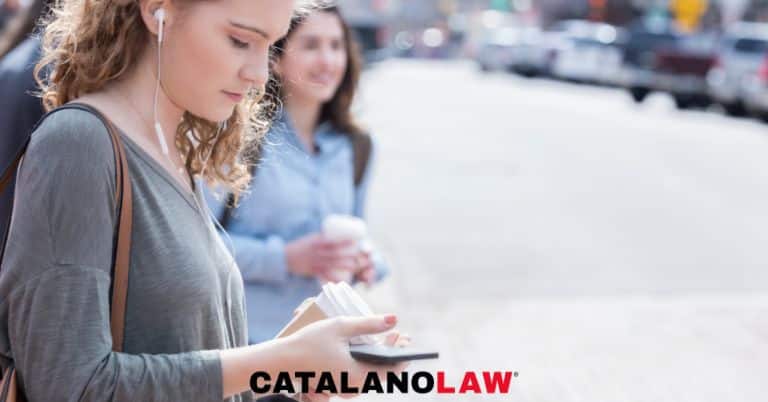
Request Free Consultation
To get answers to questions about your injury, contact Catalano Law for a FREE case evaluation. We’ll assess your case, explain your legal options, and recommend the next steps at no cost. We’re here when you need us.
Contact Form
General Contact Form

With the rise of mobile technology, distracted walking has become a growing concern for pedestrian safety. As smartphones have become essential to daily life, more people are glued to their screens while walking, increasing pedestrian accidents.
7,522 pedestrians in the U.S. lost their lives on public roads in 2022, and research shows that phone use increases the risk of pedestrian injuries in traffic accidents. One study found that over 69% of injuries, such as fractures and concussions, occurred when pedestrians were talking, and 9% happened while texting.
As Syracuse pedestrian accident lawyers, we see firsthand how distractions can lead to serious injuries or even fatalities. Learn how distracted walking contributes to pedestrian accidents and what you can do to stay safe.
Common Forms of Distractions for Pedestrians
Distracted walking is any activity that diverts a pedestrian’s attention away from their surroundings and the potential hazards around them. Some common distractions include:
- Texting: Texting while walking diverts visual and cognitive attention from one’s surroundings, making it a dangerous distraction. Pedestrians engrossed in their phones are often looking down and less aware of oncoming traffic, obstacles, or changes in traffic signals.
- Using Social Media: Scrolling through social media feeds, watching videos, or posting updates can be engaging, but this distraction can cause pedestrians to drift into the street or miss important signals and signs.
- Listening to Music or Podcasts With Headphones: Listening to music or podcasts can make a walk more enjoyable, but using headphones can limit a pedestrian’s ability to hear important sounds like car horns, sirens, or approaching vehicles. This sensory distraction reduces overall awareness.
- Talking on the Phone: Even when a pedestrian is looking ahead, talking on the phone can still be a cognitive distraction. The conversation might occupy their mind, causing them to overlook potential hazards or forget to check both ways before crossing a street.
- Engaging With Other Pedestrians or Pets: Walking with friends, handling a dog, or managing children can all be distracting. Whether you’re engaging in conversation or keeping an eye on a pet, these activities can take away the focus needed to safely navigate streets and intersections.
How Distracted Walking Reduces Awareness and Increases Risk
Distracted walking reduces a pedestrian’s awareness of their surroundings, leading to dangerous situations. Here are a few ways in which distractions affect pedestrian safety.
- Lack of Attention to Traffic Signals and Crosswalks: A distracted pedestrian may miss the signal to cross or start crossing when unsafe, increasing the risk of colliding with vehicles with the right of way.
- Inability to Assess Road Conditions: Distractions can prevent pedestrians from noticing potholes, uneven sidewalks, or other road hazards that could cause them to trip, fall, or injure themselves.
- Failure to See Oncoming Traffic: When a pedestrian’s attention is focused on their phone or another distraction, they may not see an oncoming vehicle, especially if it is turning or coming out of a blind spot.
- Reduced Reaction Time: Distracted walking reduces reaction time. Pedestrians distracted by their phones may not have enough time to react if a vehicle suddenly appears or a traffic signal changes.
Legal Implications of Distracted Walking in Pedestrian Accidents
Distracted walking can lead to serious consequences if you’re involved in a collision. While drivers are expected to exercise caution to avoid hitting pedestrians, you are also responsible for staying alert and following traffic laws.
If you’re injured in an accident because you were distracted while walking, you could be held partially responsible. In New York, which follows pure comparative negligence rules, you can still receive compensation even if you’re partly at fault. However, your award will be reduced based on your share of the blame. For instance, if you’re found 30% at fault, you’ll only recover 70% of the total damages.
Determining liability in these cases can be complicated, often requiring the experience of Syracuse pedestrian accident lawyers. Our qualified team at Catalano Law can help you manage the legal aspects of your case, negotiate with insurance companies, and win fair compensation for your injuries.
Practical Safety Tips for Pedestrians
To help prevent accidents and stay safe as a pedestrian, consider these practical tips:
- Stay Alert and Aware: Keep your head up and stay alert to your surroundings. Look both ways before crossing streets, and be aware of any approaching vehicles or changing traffic signals.
- Limit Phone Use: If you need to text, make a call, or use your phone, stop in a well-lit, safe place, such as a sidewalk or bench, before doing so.
- Avoid Using Headphones or Keep Volume Low: If you enjoy listening to music or podcasts while walking, keep the volume low or use only one earbud so you can hear what is happening around you.
- Follow Traffic Signals and Use Crosswalks: Always follow traffic signals and use crosswalks when crossing streets. Make sure you have the right of way before stepping onto the road.
- Be Extra Cautious in High-Traffic Areas: Remain extra vigilant in busy urban areas like downtown Syracuse. Watch out for turning vehicles, cyclists, and other potential hazards.
Protect Your Rights With Experienced Syracuse Pedestrian Accident Lawyers
If you’ve been involved in a pedestrian accident, our pedestrian accident lawyers at Catalano Law can help you understand your rights, determine fault, and pursue fair compensation for your injuries. We have years of experience handling pedestrian accident cases in Central New York and have won millions for our past clients.
Contact our law firm for a free consultation and let our experienced team fight for the compensation you deserve. We can help you protect your rights and secure the best possible outcome for your case.

